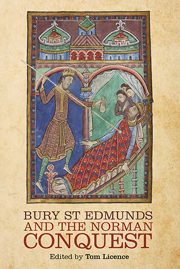Book contents
- Frontmatter
- Contents
- LIST OF ILLUSTRATIONS
- LIST OF MUSIC EXAMPLES
- LIST OF CONTRIBUTORS
- ACKNOWLEDGMENTS
- LIST OF ABBREVIATIONS
- Introduction
- 1 The Abbey and the Norman Conquest an Unusual Case?
- 2 Charters and Influences from Saint-Denis c. 1000–1070
- 3 The Abbey's Armoury of Charters
- 4 The Women of Bury St Edmunds
- 5 Baldwin's Church and the Effects of the Conquest
- 6 New Light on the Life and Work of Herman the Archdeacon
- 7 The Cult of St Edmund
- 8 St Edmund Between Liturgy and Hagiography
- 9 Books and their Use Across the Conquest
- 10 An Eleventh-Century Bury Medical Manuscript
- 11 Medicine at Bury in the Time of Abbot Baldwin
- 12 Medicine After Baldwin: The Evidence of BL, Royal 12. C. xxiv
- Index
7 - The Cult of St Edmund
Published online by Cambridge University Press: 05 August 2014
- Frontmatter
- Contents
- LIST OF ILLUSTRATIONS
- LIST OF MUSIC EXAMPLES
- LIST OF CONTRIBUTORS
- ACKNOWLEDGMENTS
- LIST OF ABBREVIATIONS
- Introduction
- 1 The Abbey and the Norman Conquest an Unusual Case?
- 2 Charters and Influences from Saint-Denis c. 1000–1070
- 3 The Abbey's Armoury of Charters
- 4 The Women of Bury St Edmunds
- 5 Baldwin's Church and the Effects of the Conquest
- 6 New Light on the Life and Work of Herman the Archdeacon
- 7 The Cult of St Edmund
- 8 St Edmund Between Liturgy and Hagiography
- 9 Books and their Use Across the Conquest
- 10 An Eleventh-Century Bury Medical Manuscript
- 11 Medicine at Bury in the Time of Abbot Baldwin
- 12 Medicine After Baldwin: The Evidence of BL, Royal 12. C. xxiv
- Index
Summary
The Pre- and Post-Conquest Cult
Most of what can be inferred about the state of Edmund's cult in the eleventh century comes from a work called Miracles of St Edmund, completed in the 1090s by a monk of the abbey who reveals that his name was Herman. He took on the allied roles of a historian and a hagiographer, inserting records of the saint's posthumous miracles into a narrative of English history and the history of Edmund's community. His work was a continuation of St Edmund's story, picking up where the account of the saint's martyrdom and early miracles left off, in the 980s, and running as far as 1096, where Herman's extant text breaks off. Herman was highly educated and literate, even for a monk. There are grounds for supposing that he trained at the abbey of St Vincent in Metz, in the heart of Lotharingia. Today Metz is in France, but in Herman's era it was part of the German Empire's network of cathedral cities, where constellations of scholars pursued the seven liberal arts. Monks of St Vincent's also specialized in the study of history, exploiting a collection of history books and nurturing the historians Alpert of Metz and Sigebert of Gembloux. Sigebert ran the monastic school in the period c. 1050–70 and went on to become the greatest chronicler of his era. St Vincent's possessed no less a constellation of saints, whose relics had been gathered from basilicas in Italy, then enshrined at Metz, by the founder, Bishop Theoderic.
- Type
- Chapter
- Information
- Bury St Edmunds and the Norman Conquest , pp. 104 - 130Publisher: Boydell & BrewerPrint publication year: 2014

